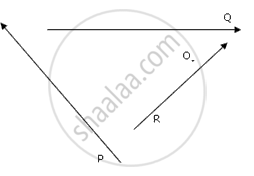Advertisements
Advertisements
प्रश्न
What should be the angle between the direction of force and the direction of motion of a body so that the work done is zero?
उत्तर
The relation between work, force, distance and angle between the two is:
W = (F) (S) cos θ
Where,
(W) - Work done
(F) - Force
(S) - Displacement
(θ) - Angle between force and displacement
When the force is perpendicular to the direction of motion, and hence, the work done is also zero.
Example - The work done by the earth on a satellite moving in a circular orbit around it is zero.
APPEARS IN
संबंधित प्रश्न
Derive a relationship between S.I. and C.C.S. unit of work
Give reasons for the following. No work is done if a man is pushing against a wall.
Express joule in terms of erg.
A boy of mass 40 kg climbs up the stairs and reaches the roof at a height 8 m in 5 s. Calculate:
- the force of gravity acting on the boy,
- the work done by him against the force of gravity,
- the power spent by boy. (Take g = 10 m s-2)
A box of weight 150 kgf has gravitational potential energy stored in it equal to 14700 J. Find the height of the box above the ground. (Take g = 9.8 N kg-1)
A boy weighing 25 kgf climbs up from the first floor at height 3 m above the ground to the third floor at height 9m above the ground. What will be the increase in his gravitational potential energy? (Take g = 10 N kg -1)
State the SI unit of work.
Define 1 joule of work.
What are the quantities on which the amount of work done depends? How are they related to work?
Why is the work done on an object moving with uniform circular motion zero?
Give two examples of couple action in our daily life.
P, Q and R are three forces which act as shown in fig.

The point O lies in the same plane. Given, P = Q = R = 10N
(i) Which force has the least moment about O? Give a reason.
(ii)Which force has the greatest moment about O? Give a reason.
A man lifts a mass of 10 kg from the floor to a shelf 4 meter high. If g = 10 ms-2, what is the work done?
What do you understand by 'potential energy' and 'Kinetic energy'? Give three examples of each to illustrate your answer.
In what way does an ‘Ideal machine’ differ from a ‘Practical machine’?
What do you understand by the term energy? Is energy a scalar or vector? How is the energy possessed by a body measured?
A truck driver can load oil drums into the back of the truck by pushing them up a sloping plank, or by lifting them directly. Each drum has a mass of 80 kg, the plank is 3 m long, and the back of the truck is 0.8 m above the ground.

(i) How much force would be needed to lift a drum into the truck directly/without using the plank? (Take g = 10 m/s2)
(ii) How much energy would be required in lifting the drum into the truck without the plank?
(iii) If the force needed to push the drum up the plank is 300 N, why is this less than the answer to part (i)?
(iv) When the truck is loaded, the driver drives off. List the major energy changes that take place in moving the truck.
(v) The driver has to stop at the factory gates. What happens to the kinetic energy of the truck?
Write the two main conditions are needed for work to be done?
